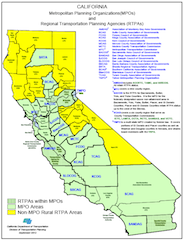Regional Agencies and Special Districts
While local governments maintain local transportation infrastructure within cities and counties, regional transportation authorities address connectivity across local jurisdictions and establish area transportation plans.
Metropolitan Planning Organizations and Regional Transportation Planning Agencies
Metropolitan planning organizations (MPOs) and regional transportation planning agencies (RTPAs) are regional agencies responsible for planning, coordinating, and administering funds for regional transportation systems.  The agencies develop 20-year regional transportation plans and five-year regional transportation improvement programs. Only metropolitan planning organizations are eligible for Federal Transportation Planning funds, and any transportation project, including pedestrian and bicycle facilities, that is not in the agency’s transportation plans is at a disadvantage for funding.
The agencies develop 20-year regional transportation plans and five-year regional transportation improvement programs. Only metropolitan planning organizations are eligible for Federal Transportation Planning funds, and any transportation project, including pedestrian and bicycle facilities, that is not in the agency’s transportation plans is at a disadvantage for funding.
A metropolitan transportation organization has five core functions:
- Establish a setting. Establish and manage a fair and impartial setting for effective regional decision-making in the metropolitan area.
- Identify alternative transportation improvement options. Use data and planning methods to generate and evaluate alternatives.
- Prepare a regional transportation plan. Develop and update a long-range transportation plan for the metropolitan area covering a planning horizon of at least 20 years that fosters:
- Mobility and access for people and goods.
- Efficient system performance and preservation.
- Good quality of life.
- Develop a transportation improvement program. Develop a short-range (four-year) program of transportation improvements based on the long-range transportation plan. The transportation improvement programs should be designed to achieve the area’s goals using spending, regulation, management and financial tools.
- Involve the public. Involve the general public and other affected constituencies in the four essential functions listed above.
A regional transportation plan should provide the following:
- Support the economic vitality of the metropolitan areas, especially by enabling global competitiveness, productivity and efficiency.
- Increase the safety of the system for users of all modes of transportation.
- Raise the transportation system’s ability to support homeland security and to safeguard the security for users of all modes of transportation.
- Improve accessibility and mobility for people and freight.
- Enhance the integration and connectivity of the transportation system, between modes, for people and freight.
- Environmental considerations:
- Protect and enhance the environment.
- Promote energy conservation.
- Improve the quality of life.
- Promote consistency between transportation projects, state and local planned growth and economic development patterns.
- Promote efficient operation and management of the system.
- Emphasize the preservation of the existing transportation system.
|
Examples: |
| The Humboldt County Association of Governments (HCAOG) is a Joint Powers Agency comprised of the seven incorporated cities (Arcata, Blue Lake, Eureka, Ferndale, Fortuna, Rio Dell, Trinidad), and the County of Humboldt. It is the designated Regional Transportation Planning Agency (RTPA) as well as the Service Authority for Freeway Emergencies (SAFE). In 2012 they developed a Regional Safe Routes to Schools Prioritization Tool, a report designed to help streamline decision-making around SR2S projects and increase the capacity for effective SR2S programs and grant applications. |
Congestion Management Agencies
Congestion management agencies are county-wide bodies funded by the state gas tax that work to keep traffic levels manageable. Congestion management agencies:
- Help coordinate land use, air quality and transportation planning among the local jurisdictions.
- Prepare a congestion management program to spend gas tax funds.
- Monitor levels of congestion on major roads.
- Analyze the impacts that a proposed development will have on future traffic congestion.
A governing body, representative of the local elected councils and agencies, is required to create congestion management programs. Generally, elected officials from these entities are appointed to the governing board to ensure local representation. As with other regional agencies, the congestion management agency has the ability to create priorities among transportation projects, thereby affecting the types of projects that receive funding in the region. For example, the Solano Transportation Agency has several different committees that focus on different types of active transportation, including safe routes to school.
County Transportation Commissions/Agencies
County transportation commissions/agencies oversee local transportation sales tax measures and prepare long-range countywide transportation plans. County transportation commissions vary from county to county; most were created as congestion management agencies. The agencies/commissions in southern California often hold significantly more authority than those in the north.
Air Quality Districts
There are 35 air quality districts in California. These agencies are area governing authorities responsible for controlling air pollution. Some districts have programs that incentivize active transportation.




